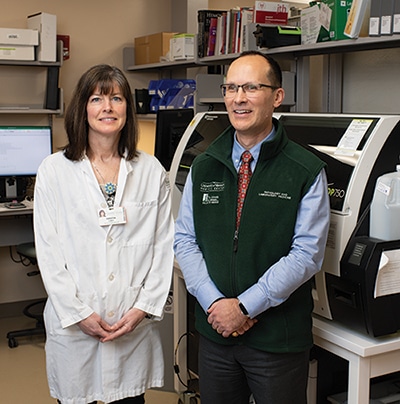Karen Titus
January 2020—D-dimer has a problem. Several problems, in fact. Many, some might say.
Let’s start with the basics regarding D-dimer assays: unit and magnitude.
Setting up the equation is easy, and the digits are small: 2 × 4. When applied to D-dimer testing, however, the answer often means far-flung problems for laboratories and clinicians.
Parsed out (for fans of James Thurber, this means channeling schoolmarm Miss Groby), D-dimer has two different units of measure. Some assays report fibrinogen equivalent units (FEU), and others measure D-dimer units (DDU). The amount of fibrin degradation products can be reported four ways based on the CAP Survey results: ng/mL, g/L, g/mL, or mg/L. “That’s eight different combinations of results coming out of the laboratory,” says Andrew Goodwin, MD, associate professor at the University of Vermont Larner College of Medicine, medical director of the coagulation laboratory, and CLIA medical director for the University of Vermont Medical Center Laboratory.

Dr. Andrew Goodwin at the University of Vermont with Kristin Lundy, CLS, technical specialist in coagulation. Dr. Goodwin and others suggest that laboratories would do well to provide more clarity to clinicians around D-dimer testing and reporting. [Photo: David Seaver]
Unlike the persnickety Miss Groby (for whom Marc Antony’s funeral oration was less about ambition and more about metonymizing ears), laboratories and clinicians are eager to consider the meaning behind the details. How should D-dimer be used to care for patients? Where does it shine? Where does it fall short? How can we do better?
To lend that broader view, however, they must consider a tidy sum of steps along the way. Or, less tidily, “This means really getting into the weeds,” says Karen Moser, MD, assistant professor of pathology at the University of Utah School of Medicine and co-medical director of the hemostasis/thrombosis laboratory, ARUP Laboratories.
Is the assay being used to evaluate deep vein thrombosis or pulmonary embolism? If so, it requires a clinically validated cutoff—but which one? The DDU versus FEU unit type should be stated clearly in the package insert, but, Dr. Moser says, “it can be a source of confusion when you’re looking at reports from different laboratories.” As she noted in her CAP19 presentation last fall, using the FEU cutoff for a DDU assay can cause false-negative results. And, Dr. Goodwin says, the D-dimer used to exclude venous thromboembolism (VTE) is valid only in patients determined by a scoring algorithm to have a low or intermediate pretest probability of VTE.
When D-dimer is used to evaluate disseminated intravascular coagulation, the results are compared to a reference interval. “That can also cause confusion,” says Dr. Moser, who was a member of the CAP Hemostasis and Thrombosis Committee through Dec. 31.

Dr. Moser
At her institution, “We have two different D-dimer test codes,” she says. “So you can order a D-dimer for VTE exclusion, and that will report the D-dimer value for the patient, as well as the D-dimer cutoff for VTE that was provided by our manufacturer and clinically validated. So you get a report that’s pertinent to that use case.” A separate D-dimer test code is used in evaluating DIC.
There is a downside to that seemingly straightforward approach. “We’re relying on people to order the correct D-dimer test for the specific clinical indication,” she says with a laugh.
“These are some of the issues that come up with the D-dimer. There are more,” she says brightly.
D-dimer harmonization issues have burbled up again with relatively recent guidelines calling for use of age-adjusted D-dimer (AADD) for evaluating patients with suspected acute pulmonary embolism, says Dr. Goodwin, also of the Hemostasis and Thrombosis Committee.For years, he says, laboratories that reported in FEU used a cutoff of 500 in some measurable unit. For laboratories that measured D-dimer in DDU, the cutoff was somewhere between 230 and 250.
So far so good. And then: “As these age-adjusted D-dimer equations started coming out, it became very obvious that people didn’t know if they were measuring D-dimer unit or fibrinogen equivalent unit,” Dr. Goodwin says. “And that completely changes the mathematics.”
Drs. Goodwin and Moser, along with others on the committee, began to notice that the literature was filling up with studies that failed to report what units were being used for measuring, and applying the published AADD could lead to mathematical and/or interpretive errors should a D-dimer result be reported in DDU. As they poked around on popular clinician decision support sites, they found further evidence that units of measure were missing in action.
This was concerning, though not surprising. “There are so many different ways the results can be reported that it’s hard for clinicians and laboratorians to keep up with it,” Dr. Goodwin says.
He and his CAP colleagues see evidence of this in CAP proficiency testing data, with labs reporting the wrong value because they were confusing DDU with FEU. Though the data are somewhat old (Olson JD, et al. Arch Pathol Lab Med. 2013;137[8]:1030–1038), close to 13 percent of laboratories reported changing type and/or magnitude of units.
Fortunately, Dr. Goodwin says, matters have improved. “It’s gotten a lot better, because we’ve been working hard to educate laboratories on this. We contacted individual laboratories” with the message that they needed to pay attention to what they report.
Another step was updating the CAP accreditation program checklist, adding a requirement and evidence of compliance that instructs the inspector to compare a patient’s final D-dimer report to the manufacturer’s product insert, making sure the units of measure and reporting values match.
“That’s driven some of the improvement we’ve seen,” Dr. Goodwin says. “But there’s certainly room for continued improvement.”
What would that improvement look like? One longtime object of desire has been a calibrator to standardize assays. For many reasons, this has remained an only half-told Hero’s Journey—those who’ve tried to push for a calibrator have found conflict but not triumph.Perhaps a Hero’s Getaway would work better. Members of the committee are ratcheting up discussions of how to standardize the process, ideally trimming that eight down to something smaller. For now, Dr. Goodwin says, they intend to play the cards they’re already holding. “Can we use what we know?” he asks.
What they know is that multiplying a DDU by a conversion factor of 1.74 (FEU = DDU × 1.74) will provide the equivalent FEU. It’s been well studied and validated, Dr. Goodwin says. Could the committee, with the assistance of the CAP, come up with an FDA-approved postanalytic conversion factor for laboratories to use? This could standardize reporting and reduce confusion.
This approach would also remove the onus on both vendors and clinicians.
The committee initially considered asking vendors to modify how they develop and market their assay kits. That idea collapsed about as quickly as the Russian Democratic Federative Republic. “I don’t think the vendors are going to want to change,” Dr. Goodwin concedes. “Why would they? They’ve got clinically validated, FDA-approved kits that work. It costs money. It’s not changing anything as far as patient care. The kits provide accurate results.”
Though the various D-dimer assays look similar, subtle differences abound. Each manufacturer has its own proprietary antibody, and each has its own R&D processes. And once a manufacturer sends its kit through the FDA approval process, Dr. Moser says, “It’s difficult to go back and resubmit, to say, ‘Actually, we want to use a different unit.’ That would require a lot of repeat studies and time and expense.”
“It’s hard to argue with that,” Dr. Goodwin acknowledges. “So we rethought our process,” turning to the idea of education and working with the FDA. These have their own challenges. The latter step will take time, he says. And vendors would still be required to take some steps—changing their product insert, for example.
Hence the appeal of having the lab handle any proposed postanalytic calculation, although labs, too, might resist, he says: We’re reporting the D-dimer, doing exactly what the manufacturer says, and now you’re telling us to add a calculation and do a calculation verification every six or 12 months, depending on the regulation.
“It does put responsibility on the lab,” Dr. Goodwin says, “but I think in the long run that’s probably the best solution. The laboratory is really good at doing postanalytic calculations. We do it for INRs.”
An FDA-approved postanalytic calculation would allow every laboratory to report in a single unit and quantity. “No matter where a clinician is practicing, the result will be the same,” says Dr. Goodwin.
There’s real value in that, he continues, including better patient safety. He says he gets calls from UVM colleagues who trained elsewhere who don’t always realize from the lab report that the D-dimer is being measured differently. (Vermont reports DDU.) “I get worried sometimes that if somebody is working through a case and accidentally overlooks what our cutoff value is, versus what they’re used to seeing—FEU in the literature, for example—they could prematurely exclude a VTE in somebody.”
Likewise, the many reporting options can be disorienting for physicians who work in different hospital systems or laboratories. “There’s a tendency, as we get comfortable with tests, that we just sort of look at the number and say, ‘Oh, yeah, I know what that means,’” Dr. Moser says. “But if you don’t pay careful attention to the unit, magnitude, and type, there’s potential to make a significant misjudgment if you’re comparing to a cutoff that isn’t appropriate for that test. And I’m not certain our clinical colleagues are totally aware of those sources of variation.”
The problem pops up even within single systems, says Jeffrey Kline, MD, vice chair of research and professor, Department of Emergency Medicine, Indiana University School of Medicine. He says he’s pushed for years—unsuccessfully—for a method that would normalize the D-dimer concentration across the IU network. “We have different D-dimers in the stat lab versus the clinical lab upstairs.” Perhaps there are good reasons for this, he says, adding that directors will likely say they strive for a standard approach. “But they still have local directors at each hospital who end up clinging to whatever test they use,” says Dr. Kline, who spoke about the perils of D-dimer testing at the 2019 annual AACC meeting also.
Obviously clarity is in big demand. Dr. Goodwin suggests an FDA-approved calculation would also offer clarity for those using age-adjusted D-dimer—they would need to use only one equation to determine the age-adjusted cutoff for excluding a VTE: age × 10.
The age-adjusted D-dimer, for those in need of a brief refresher, is based on the observation that as people age, their normal level D-dimer goes up. Those age 50 or younger have a negative value of less than 500 ng/mL FEU. A 60-year-old might have a higher D-dimer based on normal physiology, so their cutoff value would be 600 ng/mL FEU; 70-year-olds would have a 700 ng/mL FEU cutoff.
This being D-dimer, there are caveats. “You’ve got to be careful,” says Dr. Goodwin. “A lot of the data that has been published so far only takes patients up to about 75 years of age. So we don’t know if this holds true across the age spectrum, for people in the ninth and 10th decades of life.” But for those in their 50s through 70s, “we in theory could exclude a VTE using a D-dimer and not send them for follow-up scans.”
 CAP TODAY Pathology/Laboratory Medicine/Laboratory Management
CAP TODAY Pathology/Laboratory Medicine/Laboratory Management
